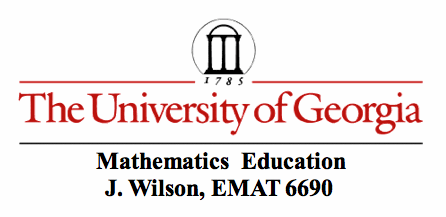

How do you construct this?? Here is a GSP file with my investigations.
Steps for Construction
1. Construct your triangle
2. Construct a line parallel to the base (AB) and a circle with radius equal to the base and center through the point which the perpendicular line goes through (B). Mark the intersection of the circle and perpendicular line.
3. Construct the segment from the intersection to the other point on the base (A). Find the midpoint of that line. 4. Construct a circle with radius equal to the midsegment just created and center A. Mark the intersection of the circle and the base.
5. Construct a parallel line through this point to the opposite side of the triangle (AC). Mark the intersection of this parallel line with the other side of the triangle (CB). This is E in my diagram.
6. Construct a parallel line through this point (E) to the base of the triangle (AB). This is D in my diagram.
7. The segment DE halves the area of the triangle
What do we know or what can we find out about the length of the parallel line segment that divides the area of our triangle into two pieces?


More investigations...
What is the ratio of the smallest triangle FGH (created by constructing the line parallel to each base that bisects the area) to the largest triangle CBA?
I have done extensive explorations and calculations with GSP for this. However, I have yet to come up with anything definitive. It is a simple matter to calculate the ratio with gsp and get the resulting decimal approximation for that. In fact, it gives
. But, I am not satisfied with a decimal approximation... The search continues.
Thanks to the help of Dr. Wilson, I made a little breakthrough and was able to come up with the mathematics and expressions behind the decimals that appeared throughout various comparisons of lengths and areas. The work below directly answers a different question and will help us in our progress to answering the question above. So, for now, let's focus on the following:
What is the ratio of the area of the triangle in purple to the original triangle?
Now, for the sake of the discussion, refer to the blue diagram below.
So the ratio of the purple triangle to the original triangle is
.
And even MORE exploration continues...
Analyze the area of the shaded regions below. In each image, the areas are congruent. Why??

We can repeat our exploration above with all three sides of the triangle to get these congruent areas.
First, for the blue shaded parallelograms. You have to focus on just a pair of parallelograms at a time. Let's take the bottom two. These are congruent since their bases are congruent and they share the same height. You repeat this process for each pair and by transitivity, you get that all the areas are the same.
Second, the trapezoids. Let's just use our analysis of the ratio of the purple triangle to the original triangle problem. Each of these green trapezoids can be thought of as the purple triangle without triangle FGH. Now we know two things: 1. The purple triangle will have the same ratio to the original triangle regardless of which side of the original triangle the base lies on. 2. Triangle FGH will always have the same area and thus have the same ratio to the original triangle Thus, we know that each of these green areas has the same ratio to the original triangle This means that the green areas are congruent.
But, this still leaves us with our primary question: What is the ratio of the center little triangle (triangle FGH) to the original triangle?
Visually, we know that the area is equal to the area of the original triangle - 3 trapezoids - 3 parallelograms. But, can we use the ratios we found above to help? Absolutely